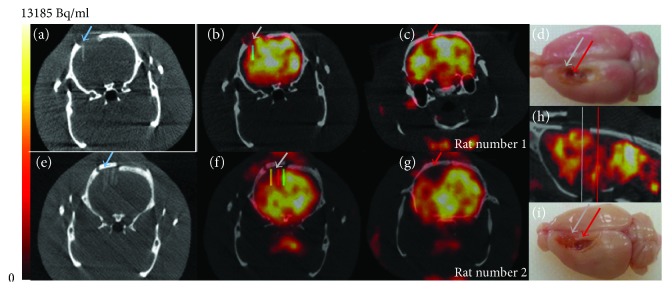Figure 3.
Measurement of cerebral blood flow by nanoSPECT Plus-CT Bioscan with [99mTc]-HMPAO. Fifteen minutes after intravenous injection of 50 MBq of [99mTc]-HMPAO in the tail vein of Sprague-Dawley anesthetized rats, data were acquired during 7 min for SPECT (48 sec and 100000 cps per projection, image size 276 × 276 × 164, 0.1 mm) and 1 min for CT (55 kVp, 500 msec, pitch 0.5, binning 1 : 4). Following the reconstruction, the CT images were spatially aligned to match the SPECT images. Processing of reconstructed images was performed with the in-house Sysiphe software [79]. Brain implants were identified on CT (blue arrows), and 3D volumes of interest (VOIs) were drawn on either side of the implants (colored rectangles) and symmetric ROIs were drawn on the contralateral side as a control (not shown). Images of two rats 20 days after a corticostriatal lesion and 7 days after implantation of neuro-implants. (a, e) CT scan of the brain implants (blue arrows). One implant was inserted in rat number 1 brain and 5 implants in rat number 2 brain. (b, f) SPECT-CT with HMPAO radiotracer on the area of the brain implant. (c, g) SPECT-CT with HMPAO radiotracer on the area of brain damage (located behind the implantation zone). We observed major hypoperfusion (red arrow). The presence of implants limited the hypoperfusion: for rat number 1, −13% in (b) compared to −25% in (c) (ROI volume was 0.4 mm3) and for rat number 2, −18% in (f) compared to −57% in (g) (ROI volume was 1.5 mm3). (h) Sagittal view of rat number 1. Coronal views (b, c) are located with grey and red lines. (d, i) Rat brain perfused and extracted 3 months after the lesion showing the lesion area where neuro-implants were inserted (grey arrows) or not (red arrows).

